牛津苏教版-英语-六年级上册-6A Unit1 Public signs第三课时教学方案
- 格式:doc
- 大小:46.50 KB
- 文档页数:6
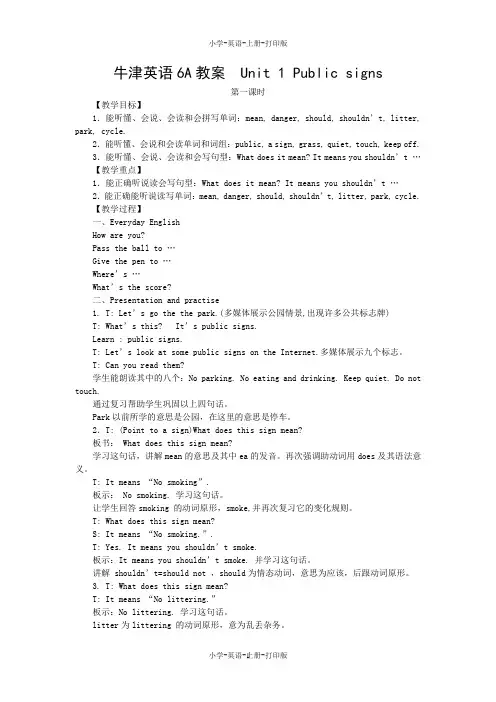
牛津英语6A教案Unit 1 Public signs第一课时【教学目标】1.能听懂、会说、会读和会拼写单词:mean, danger, should, shouldn’t, litter, park, cycle.2.能听懂、会说和会读单词和词组:public, a sign, grass, quiet, touch, keep off.3.能听懂、会说、会读和会写句型:What does it mean? It means you shouldn’t …【教学重点】1.能正确听说读会写句型:What does it mean? It means you shouldn’t …2.能正确能听说读写单词:mean, danger, should, shouldn’t, litter, park, cycle.【教学过程】一、Everyday EnglishHow are you?Pass the ball to …Give the pen to …Where’s …What’s the score?二、Presentation and practise1. T: Let’s go the the park.(多媒体展示公园情景,出现许多公共标志牌)T: What’s this? It’s public signs.Learn : public signs.T: Let’s look at some public signs on the Internet.多媒体展示九个标志。
T: Can you read them?学生能朗读其中的八个:No parking. No eating and drinking. Keep quiet. Do not touch.通过复习帮助学生巩固以上四句话。
Park以前所学的意思是公园,在这里的意思是停车。
2.T: (Point to a sign)What does this sign mean?板书: What does this sign mean?学习这句话,讲解mean的意思及其中ea的发音。
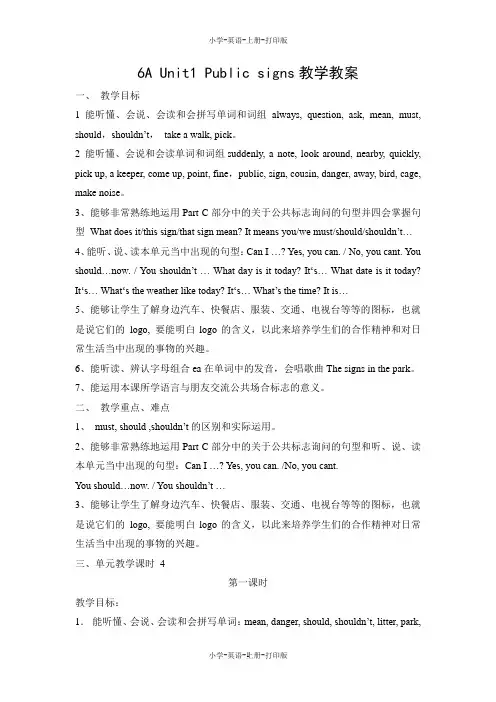
6A Unit1 Public signs教学教案一、教学目标1 能听懂、会说、会读和会拼写单词和词组always, question, ask, mean, must, should,shouldn’t,take a walk, pick。
2 能听懂、会说和会读单词和词组suddenly, a note, look around, nearby, quickly, pick up, a keeper, come up, point, fine,public, sign, cousin, danger, away, bird, cage, make noise。
3、能够非常熟练地运用Part C部分中的关于公共标志询问的句型并四会掌握句型What does it/this sign/that sign mean? It means you/we must/should/shouldn’t…4、能听、说、读本单元当中出现的句型:Can I …? Yes, you can. / No, you cant. You should…now. / You shouldn’t … What day is it today? It‘s… What date is it today? It‘s… What‘s the weather like today? It‘s… What’s the time? It is…5、能够让学生了解身边汽车、快餐店、服装、交通、电视台等等的图标,也就是说它们的logo, 要能明白logo的含义,以此来培养学生们的合作精神和对日常生活当中出现的事物的兴趣。
6、能听读、辨认字母组合ea在单词中的发音,会唱歌曲The signs in the park。
7、能运用本课所学语言与朋友交流公共场合标志的意义。
二、教学重点、难点1、must, should ,shouldn’t的区别和实际运用。
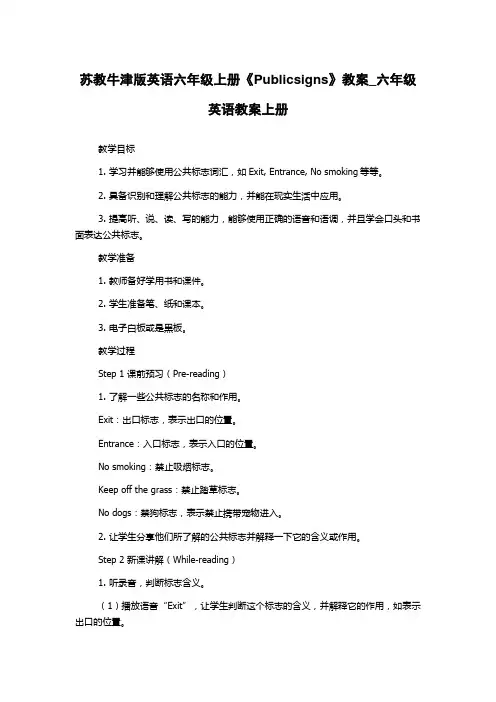
苏教牛津版英语六年级上册《Publicsigns》教案_六年级英语教案上册教学目标1. 学习并能够使用公共标志词汇,如Exit, Entrance, No smoking等等。
2. 具备识别和理解公共标志的能力,并能在现实生活中应用。
3. 提高听、说、读、写的能力,能够使用正确的语音和语调,并且学会口头和书面表达公共标志。
教学准备1. 教师备好学用书和课件。
2. 学生准备笔、纸和课本。
3. 电子白板或是黑板。
教学过程Step 1 课前预习(Pre-reading)1. 了解一些公共标志的名称和作用。
Exit:出口标志,表示出口的位置。
Entrance:入口标志,表示入口的位置。
No smoking:禁止吸烟标志。
Keep off the grass:禁止踏草标志。
No dogs:禁狗标志,表示禁止携带宠物进入。
2. 让学生分享他们所了解的公共标志并解释一下它的含义或作用。
Step 2 新课讲解(While-reading)1. 听录音,判断标志含义。
(1)播放语音“Exit”,让学生判断这个标志的含义,并解释它的作用,如表示出口的位置。
(2)按照此方法继续播放其它标志的语音,让学生来判断含义。
2. 图片辨认(1)用PPT展示图片,让学生观察并猜想标志的含义。
(2)老师讲解标志的含义,并强调它的作用。
3. 句型练习(1)展示“Exit”,说出“Where is the exit?”,让学生听并复述。
(2)老师随机选择一些标志的图片,让学生使用“In the….”“On the….”“At the….”这样的短语来练习问答句型。
Step 3 练习(Post-reading)1. 写作练习(1)要求学生写一个公共标志,并解释它的作用。
如:No smoking, 表示禁止吸烟;Keep off the grass,表示禁止踏草。
(2)要求学生写一个短文,描述自己所了解的公共标志。
这样能够帮助学生复习词汇以及让他们在语言中获得更多的练习。
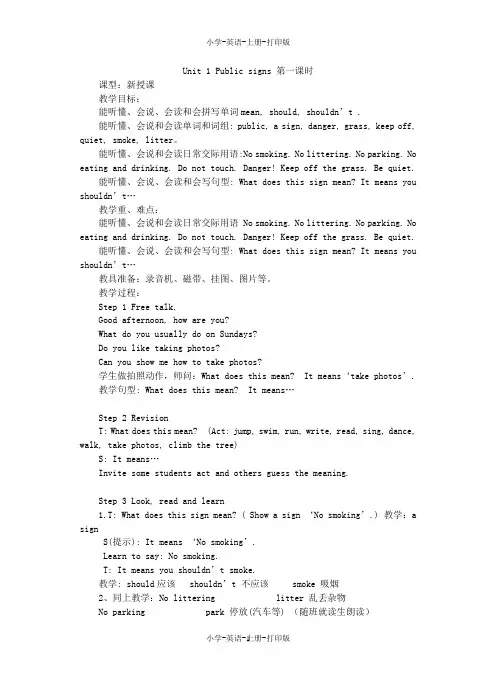
Unit 1 Public signs 第一课时课型:新授课教学目标:能听懂、会说、会读和会拼写单词mean, should, shouldn’t .能听懂、会说和会读单词和词组: public, a sign, danger, grass, keep off, quiet, smoke, litter。
能听懂、会说和会读日常交际用语:No smoking. No littering. No parking. No eating and drinking. Do not touch. Danger! Keep off the grass. Be quiet.能听懂、会说、会读和会写句型: What does this sign mean? It means you shouldn’t…教学重、难点:能听懂、会说和会读日常交际用语 No smoking. No littering. No parking. No eating and drinking. Do not touch. Danger! Keep off the grass. Be quiet.能听懂、会说、会读和会写句型: What does this sign mean? It means you shouldn’t…教具准备:录音机、磁带、挂图、图片等。
教学过程:Step 1 Free talk.Good afternoon, how are you?What do you usually do on Sundays?Do you like taking photos?Can you show me how to take photos?学生做拍照动作,师问:What does this mean? It means‘take photos’.教学句型: What does this mean? It means…Step 2 RevisionT: What does this mean? (Act: jump, swim, run, write, read, sing, dance, walk, take photos, climb the tree)S: It means…Invite some students act and others guess the meaning.Step 3 Look, read and learn1.T: What does this sign mean? ( Show a sign ‘No smoking’.) 教学:a signS(提示): It means ‘No smoking’.Learn to say: No smoking.T: It means you shouldn’t smoke.教学: should应该 shouldn’t 不应该 smoke 吸烟2、同上教学:No littering litter 乱丢杂物No parking park 停放(汽车等) (随班就读生朗读)No eating or drinking eat or drink 吃和喝Do not touch 禁止触摸。
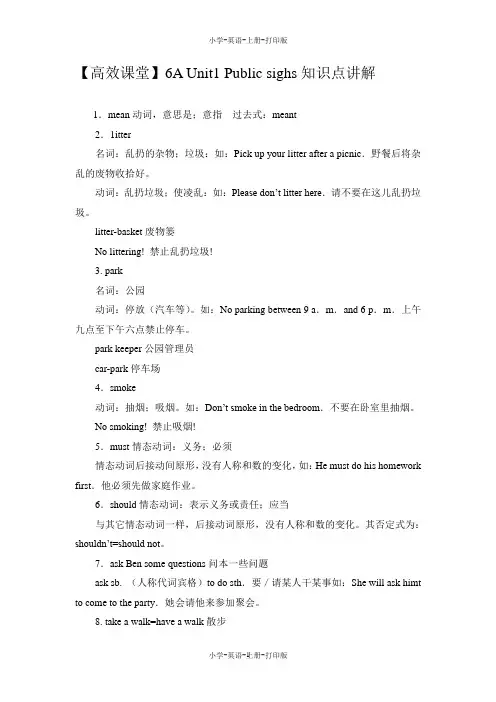
【高效课堂】6A Unit1 Public sighs知识点讲解1.mean动词,意思是;意指过去式:meant2.1itter名词:乱扔的杂物;垃圾:如:Pick up your litter after a picnic.野餐后将杂乱的废物收拾好。
动词:乱扔垃圾;使凌乱:如:Please don’t litter here.请不要在这儿乱扔垃圾。
litter-basket废物篓No littering! 禁止乱扔垃圾!3. park名词:公园动词:停放(汽车等)。
如:No parking between 9 a.m.and 6 p.m.上午九点至下午六点禁止停车。
park keeper公园管理员car-park停车场4.smoke动词:抽烟;吸烟。
如:Don’t smoke in the bedroom.不要在卧室里抽烟。
No smoking! 禁止吸烟!5.must情态动词:义务;必须情态动词后接动间原形,没有人称和数的变化,如:He must do his homework first.他必须先做家庭作业。
6.should情态动词:表示义务或责任;应当与其它情态动词一样,后接动词原形,没有人称和数的变化。
其否定式为:shouldn’t=should not。
7.ask Ben some questions问本一些问题ask sb. (人称代词宾格)to do sth.要/请某人干某事如:She will ask himt to come to the party.她会请他来参加聚会。
8. take a walk=have a walk散步Go for a walk去散步9.pickup捡起pick the purse up=pick up the purse当动作对象是人称代词宾格时,必须放在动词与副词之间:如:pick it/them up10.give sb. sth.=give sth.to sb. 给某人某物当sth.是代词时,只能用give sth.To sb.如:give it/them to Nancy11.Come up to sb.走到某人面前如:The teacher suddenly comes up to David. 老师突然走到了戴维面前。
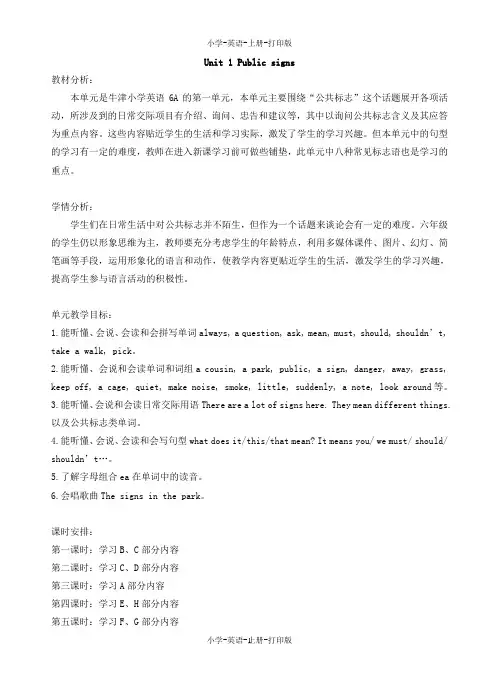
Unit 1 Public signs教材分析:本单元是牛津小学英语6A的第一单元,本单元主要围绕“公共标志”这个话题展开各项活动,所涉及到的日常交际项目有介绍、询问、忠告和建议等,其中以询问公共标志含义及其应答为重点内容。
这些内容贴近学生的生活和学习实际,激发了学生的学习兴趣。
但本单元中的句型的学习有一定的难度,教师在进入新课学习前可做些铺垫,此单元中八种常见标志语也是学习的重点。
学情分析:学生们在日常生活中对公共标志并不陌生,但作为一个话题来谈论会有一定的难度。
六年级的学生仍以形象思维为主,教师要充分考虑学生的年龄特点,利用多媒体课件、图片、幻灯、简笔画等手段,运用形象化的语言和动作,使教学内容更贴近学生的生活,激发学生的学习兴趣,提高学生参与语言活动的积极性。
单元教学目标:1.能听懂、会说、会读和会拼写单词always, a question, ask, mean, must, should, shouldn’t, take a walk, pick。
2.能听懂、会说和会读单词和词组a cousin, a park, public, a sign, danger, away, grass, keep off, a cage, quiet, make noise, smoke, little, suddenly, a note, look around等。
3.能听懂、会说和会读日常交际用语There are a lot of signs here. They mean different things.以及公共标志类单词。
4.能听懂、会说、会读和会写句型what does it/this/that mean? It means you/ we must/ should/ s houldn’t…。
5.了解字母组合ea在单词中的读音。
6.会唱歌曲The signs in the park。
课时安排:第一课时:学习B、C部分内容第二课时:学习C、D部分内容第三课时:学习A部分内容第四课时:学习E、H部分内容第五课时:学习F、G部分内容。
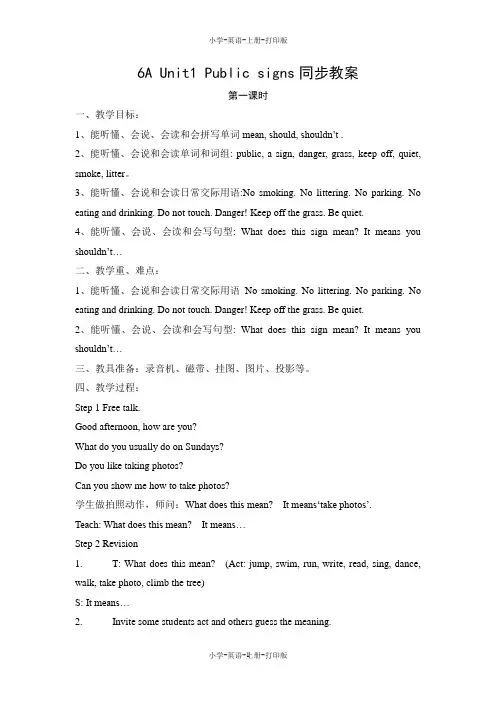
6A Unit1 Public signs同步教案第一课时一、教学目标:1、能听懂、会说、会读和会拼写单词mean, should, shouldn’t .2、能听懂、会说和会读单词和词组: public, a sign, danger, grass, keep off, quiet, smoke, litter。
3、能听懂、会说和会读日常交际用语:No smoking. No littering. No parking. No eating and drinking. Do not touch. Danger! Keep off the grass. Be quiet.4、能听懂、会说、会读和会写句型: What does this sign mean? It means you shouldn’t…二、教学重、难点:1、能听懂、会说和会读日常交际用语No smoking. No littering. No parking. No eating and drinking. Do not touch. Danger! Keep off the grass. Be quiet.2、能听懂、会说、会读和会写句型: What does this sign mean? It means you shouldn’t…三、教具准备:录音机、磁带、挂图、图片、投影等。
四、教学过程:Step 1 Free talk.Good afternoon, how are you?What do you usually do on Sundays?Do you like taking photos?Can you show me how to take photos?学生做拍照动作,师问:What does this mean? It means‘take photos’.Teach: What does this mean? It means…Step 2 Revision1. T: What does this mean? (Act: jump, swim, run, write, read, sing, dance, walk, take photo, climb the tree)S: It means…2. Invite some students act and others guess the meaning.Step 3 Look, read and learn1.T: What does this sign mean? ( Show a sign ‘No smoking’.)S(提示): It means ‘No smoking’.Learn to say: No smoking.T: It means you shouldn’t smoke. Teach: smoke 吸烟2、同上教学:No littering litter 乱丢杂物No parking park 停放(汽车等)No eating or drinking eat or drink 吃和喝Do not touch 禁止触摸。
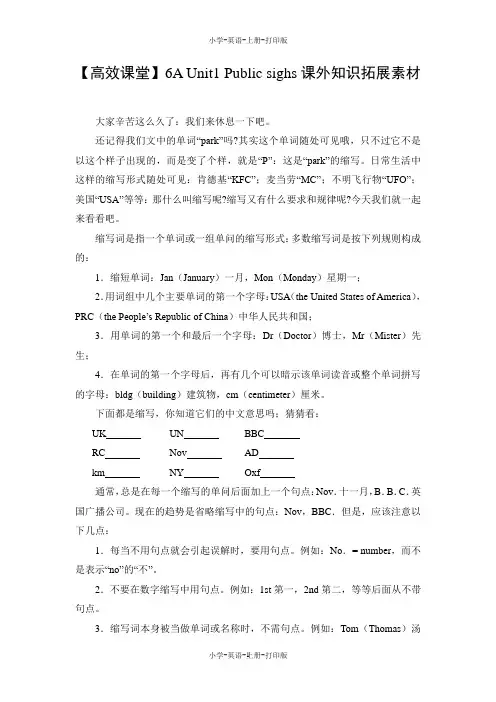
【高效课堂】6A Unit1 Public sighs课外知识拓展素材大家辛苦这么久了:我们来休息一下吧。
还记得我们文中的单词“park”吗?其实这个单词随处可见哦,只不过它不是以这个样子出现的,而是变了个样,就是“P”:这是“park”的缩写。
日常生活中这样的缩写形式随处可见:肯德基“KFC”;麦当劳“MC”;不明飞行物“UFO”;美国“USA”等等:那什么叫缩写呢?缩写又有什么要求和规律呢?今天我们就一起来看看吧。
缩写词是指一个单词或一组单问的缩写形式:多数缩写词是按下列规则构成的:1.缩短单词:Jan(January)一月,Mon(Monday)星期一;2.用词组中几个主要单词的第一个字母:USA(the United States of America),PRC(the People’s Republic of China)中华人民共和国;3.用单词的第一个和最后一个字母:Dr(Doctor)博士,Mr(Mister)先生;4.在单词的第一个字母后,再有几个可以暗示该单词读音或整个单词拼写的字母:bldg(building)建筑物,cm(centimeter)厘米。
下面都是缩写,你知道它们的中文意思吗;猜猜看:UK RC km UNNovNYBBCADOxf通常,总是在每一个缩写的单问后面加上一个句点:Nov.十一月,B.B.C.英国广播公司。
现在的趋势是省略缩写中的句点:Nov,BBC.但是,应该注意以下几点:1.每当不用句点就会引起误解时,要用句点。
例如:No.= number,而不是表示“no”的“不”。
2.不要在数字缩写中用句点。
例如:1st第一,2nd第二,等等后面从不带句点。
3.缩写词本身被当做单词或名称时,不需句点。
例如:Tom(Thomas)汤姆。
UK英国UN联合国BBC英国广播公司RC红十字会Nov11月AD公元km千米NY纽约Oxf牛津。
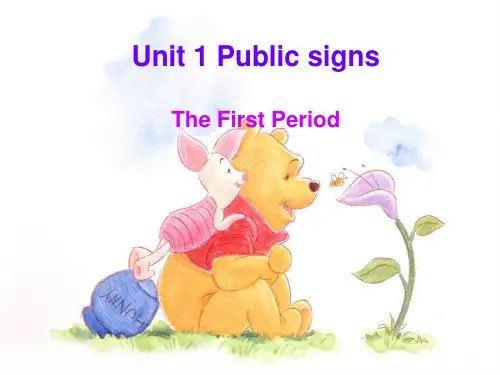
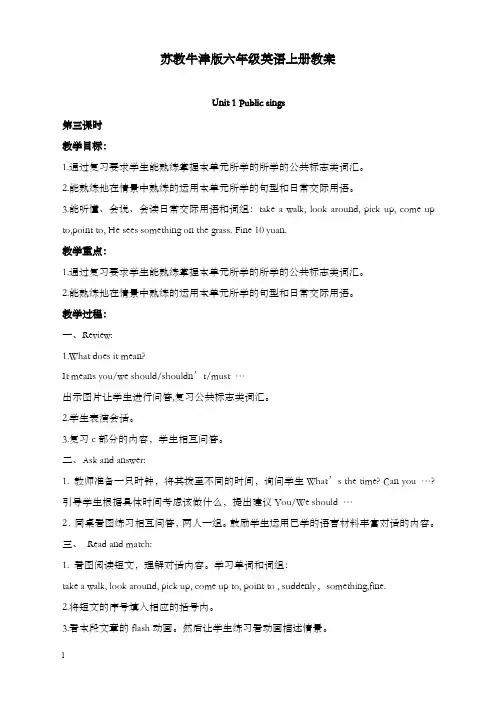
苏教牛津版六年级英语上册教案Unit 1 Public sings第三课时教学目标:1.通过复习要求学生能熟练掌握本单元所学的所学的公共标志类词汇。
2.能熟练地在情景中熟练的运用本单元所学的句型和日常交际用语。
3.能听懂、会说、会读日常交际用语和词组:take a walk, look around, pick up, come up to,point to, He sees something on the grass. Fine 10 yuan.教学重点:1.通过复习要求学生能熟练掌握本单元所学的所学的公共标志类词汇。
2.能熟练地在情景中熟练的运用本单元所学的句型和日常交际用语。
教学过程:一、Review:1.What does it mean?It means you/we should/shouldn’t/must …出示图片让学生进行问答,复习公共标志类词汇。
2.学生表演会话。
3.复习c部分的内容,学生相互问答。
二、Ask and answer:1. 教师准备一只时钟,将其拨至不同的时间,询问学生What’s the time? Can you …?引导学生根据具体时间考虑该做什么,提出建议You/We should …2.同桌看图练习相互问答,两人一组。
鼓励学生运用已学的语言材料丰富对话的内容。
三、Read and match:1. 看图阅读短文,理解对话内容。
学习单词和词组:take a walk, look around, pick up, come up to, point to , suddenly,something,fine.2.将短文的序号填入相应的括号内。
3.看本段文章的flash动画。
然后让学生练习看动画描述情景。
4.学生看动画描述。
四、Assignment:1. 抄写本课的四会单词和句型并默写。
2. 熟读课文对话并试着背诵。
教后感:学以致用是教学的目的,在这一课中,我让学生表演会话,让学生描述flash 的内容,以锻炼学生的口头表达能力。
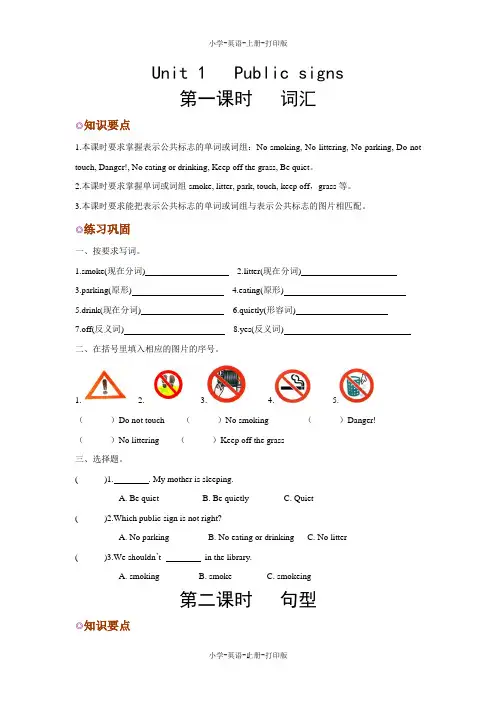
Unit 1 Public signs第一课时词汇◎知识要点1.本课时要求掌握表示公共标志的单词或词组:No smoking, No littering, No parking, Do not touch, Danger!, No eating or drinking, Keep off the grass, Be quiet。
2.本课时要求掌握单词或词组smoke, litter, park, touch, keep off,grass等。
3.本课时要求能把表示公共标志的单词或词组与表示公共标志的图片相匹配。
◎练习巩固一、按要求写词。
1.smoke(现在分词)2.litter(现在分词)3.parking(原形)4.eating(原形)5.drink(现在分词)6.quietly(形容词)7.off(反义词) 8.yes(反义词)二、在括号里填入相应的图片的序号。
1. 2. 3. 4. 5.()Do not touch ()No smoking ()Danger!()No littering ()Keep off the grass三、选择题。
( )1. . My mother is sleeping.A. Be quietB. Be quietlyC. Quiet( )2.Which public sign is not right?A. No parkingB. No eating or drinkingC. No litter( )3.We shouldn’t in the library.A. smokingB. smokeC. smokeing第二课时句型◎知识要点1.本课时要求掌握的句型是:What does it/this/that sign mean? It means you/we should/shouldn’t ┅. Can I ┅? No, you can’t. You should ┅now.2.本课时要求能把句型与所学的单词结合起来进行问答练习。
【高效课堂】6A Unit1 Public sighs拓展阅读素材A Funny ManMr Green has a holiday, so he says, “I’m going to the mountains(山)by train.” He puts on his best(最好的)clothes, takes a small bag, goes to the station and gets into the train. He has a beautiful hat, and he often puts his head out of the window during(在……期间)the trip and looks at the mountains. But tile wind blows (吹)his hat off. Mr Green quickly takes his bag and throws(扔)that out of the window, too.The other people in the train laugh, “Is your bag g oing to bring your beautiful hat back?” they ask.“No,” Mr Green answers, “But there’s no name and no address(地址)on my hat, and there’s a name and an address on the bag. Someone is going to find both of them, and he’s going to send(寄)me the bag and t he hat.”A.阅读短文,判断下列句子的正误,“T”表示正确,“F”表示错误。
1. Mr Green often sleeps in the train.2. Mr Green throws his hat out of the window.3. There’s a name and an address on the bag.4. The people in the train laugh at Mr Green.B.阅读短文,选择正确的答案。
牛津小学英语6A各单元整理笔记1 Unit 1 Public signs一、词组:1. No smoking(禁止吸烟)/ smoke(吸烟)2. No littering(禁止乱丢杂物)/ litter (乱丢杂物)3. No parking(禁止停车)/ park(停车)4. Do not touch(禁止触摸)5. Danger(危险)6. No eating or drinking(禁止吃喝)7. Keep off the grass(不接近草坪)/ keep off(不接近)8. Be quiet / keep quiet(保持安静)9. his cousin(他的表弟)10. only four years old(仅仅只有四岁)11. a lot of questions(许多问题)12. some public signs(一些公共标志)13. ask ?? some questions(问??一些问题)14. mean different things(表示不同的意思)15. stay away from ??(远离??)16. walk on the grass(在草地上行走)17. the sign on the bird’s cage(鸟笼上的标志)18. make noise(发出吵闹声)19. know a lot about public signs(关于公共标志懂得很多)20. near the bird’s cage(在鸟笼附近)21. take a walk(散步)22. see something(看见某物)23. a ten-yuan note(一张十元纸币)24. look around(环顾四周)25. walk to the note(走向那张纸币)26. pick up ??(捡起??)/ pick it up(捡起它)27. a park keeper(一位公园看守者)28. come up to??(向??走上前来)29. point to a sign(指向一个标志)30. say to ??(对??说)31. Can’t you see ???(你没看见??吗?)32. fine ??10(罚款10 元)33. shouldn’t =should not(不应该)/ should(应该)always 总是must 必须suddenly 突然地nearby 附近的quickly 快地二、句型:1. What does this sign /that sign /it mean? It means you/we shouldn’t /should /must ??2. Can I ?? ? No, you can’t. You should ?? now.三、语法:1. mean 的用法。
6A Unit1 (Part EFGH) 教学方案年级:6年级单元:Unit 1课题:Public signs 课型:新授课教学目标: 1. 掌握单词、词组take a walk, suddenly, a note, nearby, pick up. park keeper, come up to, point to, shake.2. 能看懂E部分小故事并完成练习。
3.了解字母组合ea在单词中的读音4.会唱歌曲The signs in the park重点难点:E部分短文教学过程第一步:复习(单元重点内容)T: (PPT 1 显示课题)Hello, boys and girls. Nice to meet you again.T: 在第一单元中,我们已经学习了一些公共标志,以及如何去谈论这些公共标志。
你都记住了吗?现在老师就来考考你。
请你读一读下面对于各个标志的描述,从备选栏中选择出相应的标志,说出序号和标志语。
Are you ready?( PPT2显示4条描述语言)T: The first one, It means we shouldn’t smoke here. What is the sign? (稍停)T: Yes. This one, no smoking. (PPT显示答案)T: And the second one , it means we shouldn’t put the car here. (稍停)T: Yes. This one, no parking. (PPT显示答案)(相同方法依次呈现其他2个标志,PP3 4个标志同上)It means we shouldn’t litter here. No litteringIt means we shouldn’t touch it. Do not touchIt means we shouldn’t drink or eat here. No eating or drinkingIt means we should stay away from here. Danger!It means we shouldn’t make noise here. Be quietIt means we shouldn’t walk on the grass. Keep off the grass.(本步骤设计说明:通过本步骤学生能够在教师的帮助下把有关标志语和本单元相关句型进行回忆和再现。
)第二步:完成各版块教学㈠E部分1.T: OK. 刚才我们一起再次回忆了本单元的公共标志,其实公共标志真的很重要哦!你看下面这位Mr Smith就是因为没有看到公园里的公共标志而被罚了款呢!请你先自己来读一读这个小故事吧!(动画播放Part E小故事内容)T: OK. Now can you try to answer me some questions? 请你来回答老师的几个问题吧!(PPT4依次显示问题,教师边呈现边读句子)Q1: What is Mr Smith doing in the park?Q2: What does he see on the grass?Q3: What does he do?Q4: Who comes up to Mr Smith and what does he say?2.T: 看完了问题,请你再到文中去找找问题的答案吧,你也可以和同学进行讨论。
3.T: The first question: What is Mr Smith doing in the park? (稍停)Yes. He is taking a walk in the park.(PPT5呈现答案句)Now please read thisphrase. 请注意这个新的短语:(点击出现词组)take a walk (教授带读)T: The second question: What does he see on the grass? (稍停)Right. He sees a ten yuan note on the grass.(PPT6呈现答案句)Suddenly, he see something. And that is a ten yuan note. Now please read after me:(点击出现词组)(note,suddenly, (分别教授两个单词带读)T: OK. The next question: What does he do? (稍停)He looks around and quickly walks to the note and picks it up.(PPT7呈现答案句)Now please read this phrase. 请注意这个新的短语:(点击出现词组)pick up (教授带读)T: Mr Smith looks around before he pick up the note. 在史密斯先生拣起钱之前他左右环顾了一圈,is there anyone near him? (稍停) No, there isn’t. So we can say: There’s no one nearby. Read after me: nearby (点击出现词组)(教授带读)T: And now the last question: Who comes up to Mr Smith and what does he say?(稍停) 这个问题的答案比较长,请你试着和老师一起来读一读。
(PPT8 呈现答案段落)(教师放慢语速带读半分钟)T: Nice try! 刚才你遇到新单词和短语了吗?我们一起来学一学吧!A park keeper comes up to Mr Smith. Read after me: a park keeper. (点击出现词组)(教授带读) He points to a sign. (点击出现词组)Read after me: point to.(教授带读)4. T: OK. I think you can read this story well now. 现在就请你自己再大声朗读这个小故事一遍,完成第11页上练习,(PPT9 显示4幅图)给每幅图找到相应的文字解说。
(学生做练习)5.OK. Do you get the same answer as mine? 你的答案和老师的一样吗?(点击出现答案)Good!㈡F部分1.T: Well, this is an interesting story I think. Now let’s play an interesting game, OK? 在刚才的小故事之后我们来做一个有趣的游戏吧!Let’s draw and guess! But how to play? Let me show you. Ben, Nancy and Jack are playing this game now. first let’s watch. (播放动画)2.T: 你读懂了吗?在这个游戏中,一个同学分步骤画出自己想要画的公共标志,其他同学可以根据画的内容猜测是什么标志。
好了,现在就请你也来玩一玩这个游戏吧!㈢G部分1. T: OK. So much for the game. 游戏我们先做到这里,如果你有兴趣,还可以在课后和同学继续玩。
Now, please read these for words. 请你来读一读这四个单词。
(PPT10 显示G部分四个单词)2.T: Now please read after me: (教师带读bread, breakfast, head, sweater)请你自己再读一读想一想,在这四个单词中字母组合ea的发音是什么呢?3. T: Right! 这里字母组合ea的发音是(点击显示音标,教师示范带读)4. T: Now can you put these words into one or two sentences. 你能动动脑筋把以上的四个单词放到一到两个句子中吗?和同学一起讨论讨论吧!5. T: 相信你一定有了自己的答案,现在请你来读一读书上的句子吧!(PPT11 显示G部分句子带读)Now read after me: The boy in the green sweater is shaking his head. He does not want bread for breakfast. 这里我们有一个新单词,now read after me: shake ( 教授,带读)6. T: Good! 这里老师还给你们搜集了类似的单词,请你们自己来读一读。
(PPT12 显示单词,学生读单词)㈤H部分1.T: 最后我们一起来学习一首有关公共标志的歌曲吧——the signs in the park.先请你来听一听!First let’s listen. (课件播放歌曲)2.T: 在这首歌中有两个新单词,let’s learn. First, rubbish( 教授,带读) Andsecond: bin (PPT15 ( 教授,带读)3. T: Now let’s listen to it again. This time you can try to sing. (课件播放歌曲)3.T: 这首歌曲可以很好地帮我们复习有关公共标志的知识。
希望你在课后也可以练习唱一唱。
(本步骤设计说明:在本步骤中教师通过各种不同的形式带领学生学习新知,以游戏形式操练旧知,以拓展形式训练语音,以练习形式学习歌曲,不会让学生在这样的课中感觉枯燥,乐于参与,积极思考。
)(结束语)T: 在第一单元中,我们一起学习了有关各种公共标志的语言知识。
相信你在今后的学习生活中能很好的运用所学到的知识进行交流。
Bye!本节课说明:本节课上首先教师带领学生复习了这个单元已经习得的知识,为后面的学习打下了基础。
然后教师针对不同版块设计了不同形式的学习方法。
例如在短文部分,教师设计了若干问题,然后在回答问题的过程中再进行新知的教授,注重培养学生自己阅读的能力。
在游戏部分,教师也没有直接说出规则,让是学生通过自己读了解游戏规则。
在语音部分,教师也没有把句子直接给学生,而是让学生发挥自己的想象力组织语言。
总的来说,在这样的版块复习课型中,教师既要注重对单元知识的不断巩固,还要注重新知识的教授,同时还要兼顾趣味与实用性。